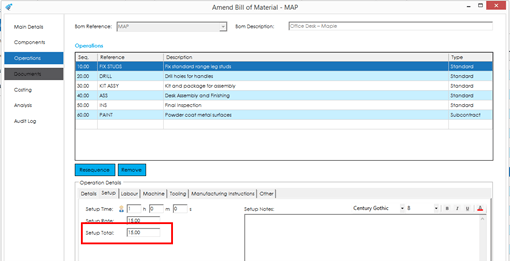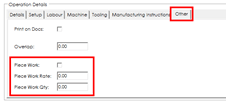A BOM Cost is broken down into separate cost headings as explained in the Costing introduction. The BOM Costing process uses the following calculations when calculating the costs for each of these cost headings.
Knowledgebase
Home > Knowledgebase > Cim50 > Bill of Materials > Costing > Calculations
A BOM Cost is broken down into separate cost headings as explained in the Costing introduction. The BOM Costing process uses the following calculations when calculating the costs for each of these cost headings.
The value calculated in the material cost heading includes the cost of all purchased component items throughout the BOM structure, and depending on the ‘Roll-up Costs’ setting, could also include Labour, Setup, Machine, Subcontract, Tooling & Overheads from sub-assembly items within the BOM structure too.
How the value is calculated is controlled by the ‘Costing Basis’ setting, either using the Last Cost Price, or Average Cost Price, as the basis for costing calculations.
With ‘Roll-Up Costs’ enabled; material costs contain only purchased component item costs throughout the BOM structure. Non-material costs described above are separated out into their individual cost headings.
As such, the system will calculate a cost for each component on the BOM, along with components referenced in sub-assemblies associated with the BOM. The following formula is used against each purchased component item to calculate the material cost.
Costing Basis – Last Cost Price
Bom Component Quantity * Stock Record Last Cost Price.
Costing Basis – Average Cost Price
Bom Component Quantity * Stock Record Average Cost Price.
The result of the above formula is summed together for each component item to produce the total material cost.
With ‘Roll-Up Costs’ disabled, material costs contain the purchased component item costs throughout the BOM structure, along with Non-material costs such as Labour, Machine, Sub-Contract etc. from any sub-assembly BOMs.
Purchase component items costs are calculated in the same methodology as described above. The following formula is used against each purchased component item to calculate the material cost.
Costing Basis – Last Cost Price
Material Cost = Bom Component Quantity * Stock Record Last Cost Price.
Costing Basis – Average Cost Price
Material Cost = Bom Component Quantity * Stock Record Average Cost Price.
The result of the above formula is summed together for each component item, along with the Labour, Setup, Machine, Tooling, Subcontract, and Overhead costs from any associated sub-assemblies, to produce the total material cost.
The value calculated in the setup cost heading, includes the setup cost defined on all standard operations on the BOM being costed. Depending on the ‘Roll-up Costs’ setting, it could also include setup costs from standard operations defined on sub-assembly items within the BOM structure as well.
The calculation of setup cost is very simple. The system reads all standard operations on the BOM being costed and adds the ‘Setup Total’ value together. As above, with ‘Roll-Up Costs’ enabled, it will also include the same figure from operations on sub-assembly BOMs.
You can locate the setup total on the BOM Operations Details ‘Setup’ tab, as indicated in the screenshot below:
The setup values from each operation are summed together for each standard operation, along with the setup costs from any associated sub-assemblies (if applicable), to produce the total setup cost.
There are 2 methods for costing labour in Cim50. The method used is determined based on whether a standard operation is defined as being a ‘Piece Work’ operation or not. This flag is located on the ‘Other’ tab within the operation details section of a standard operation.
The value calculated in the labour cost heading includes the Labour cost defined on all standard operations on the BOM being costed. Depending on the ‘Roll-up Costs’ setting, it could also include labour costs from standard operations defined on sub-assembly items within the BOM structure as well.
For operations that utilise standard labour costing, the calculation for labour costs is calculated in 2 stages. As above, depending on the ‘Roll-Up Costs’ setting, it will also run the same calculation against operations on sub-assembly BOMs that utilise standard costing.
Firstly, the system works out the Number of Runs (Runs) required to manufacture the amount being costed.
Runs = Bom Cost Qty / Operation Qty Per Run.
Once it knows how many runs are required, it takes that figure, and multiplies it by the Labour Total, to calculate the labour cost to manufacture the quantity being costed.
Labour Cost = Runs * Labour Total
For operations that utilise piece work costing, the calculation for labour costs is calculated via a simple formula. As above, depending on the ‘Roll-Up Costs’ setting, it will also run the same calculation against operations on sub-assembly BOMs that utilise piece work costing.
The formula for calculating piece work costs is as follows:
Labour Cost = (Piece Work Rate / Piece Work Qty) * Bom Cost Qty
The piece work rate and quantity can be located on the ‘Other’ tab as per the previous screenshot.
The labour costs from each operation are summed together for each standard operation, along with the labour costs from any associated sub-assemblies (if applicable), to produce the total labour cost.
The value calculated in the machine cost heading includes the machine cost defined on all standard operations on the BOM being costed. Depending on the ‘Roll-up Costs’ setting, it could also include machine costs from standard operations defined on sub-assembly items within the BOM structure as well.
The calculation for machine costs is calculated in 2 stages. As above, depending on the ‘Roll-Up Costs’ setting, it will also run the same calculation against operations on sub-assembly BOMs.
Firstly, the system works out the Number of Runs (Runs) required to manufacture the amount being costed.
Runs = Bom Cost Qty / Operation Qty Per Run.
Once it knows how many runs are required, it takes that figure, and multiplies it by the Machine Total, to calculate the machine cost to manufacture the quantity being costed.
Machine Cost = Runs * Machine Total
The machine costs from each operation are summed together for each standard operation, along with the machine costs from any associated sub-assemblies (if applicable), to produce the total machine cost.
The value calculated in the sub-contract cost heading includes the sub-contract cost defined on all subcontract operations on the BOM being costed. Depending on the ‘Roll-up Costs’ setting, it could also include sub-contract costs from subcontract operations defined on sub-assembly items within the BOM structure as well.
The sub-contract cost is calculated based on the preferred supplier, along with the quantity/price breaks defined on the operation.
Firstly, the system locates the preferred supplier, then establishes which quantity break is appropriate, based on the quantity being costed.
Warning – If the quantity being costed does not fall inside any of the quantity breaks defined, the system will cost the operation at zero value.
It then determines if the cost rate defined in the quantity break is on a “per item” basis or not. The following calculation is then performed:
Per Item Basis
Subcontract Cost = Bom Cost Qty * Preferred Supplier Subcontract Rate
Non Per Item Basis
Subcontract Cost = Preferred Supplier Subcontract Rate
The subcontracts costs from each operation are summed together for each subcontract operation, along with the subcontract costs from any associated sub-assemblies (if applicable), to produce the total subcontract cost.
The value calculated in the tooling cost heading includes the tooling cost defined on all standard operations on the BOM being costed. Depending on the ‘Roll-up Costs’ setting, it could also include tooling costs from standard operations defined on sub-assembly items within the BOM structure as well.
The calculation for tooling costs is calculated via a simple formula. As above, depending on the ‘Roll-Up Costs’ setting, it will also run the same calculation against operations on sub-assembly BOMs.
The formula for calculating tooling costs is as follows:
Tooling Cost = Tooling Resource Cost / (Bom Cost Qty / Tool Resource Quantity)
The tooling resource cost and quantity can be located on the ‘Tooling’ tab.
The tooling costs from each operation are summed together for each standard operation, along with the tooling costs from any associated sub-assemblies (if applicable), to produce the total tooling cost.
The value in the overheads cost heading includes the overheads cost calculated, based on the overhead percentages defined on the BOM, and the material, labour, and machine costs. Depending on the ‘Roll-up Costs’ setting, it could also include overhead costs from sub-assembly items within the BOM structure as well.
There are 3 parts to the overhead’s calculations:
Material Overheads
Material Overheads = (Material Cost / 100) * BOM Material Overhead Rate
Labour Overheads
Labour Overheads = (Labour Cost / 100) * Bom Labour Overhead Rate
Machine Overheads
Machine Overheads = (Machine Cost / 100) * Bom Machine Overhead Rate
Overhead Cost = Material Overheads + Labour Overheads + Machine Overheads
The overhead costs from each component/operation are summed together, along with the overhead costs from any associated sub-assemblies (if applicable), to produce the total overhead cost.
The unit cost price is calculated using the following formula:
Unit Cost Price = (Material Cost + Setup Cost + Labour Cost + Machine Cost + Subcontract Cost + Tooling Cost + Overheads Cost) / Bom Cost Qty
Depending on the ‘Post Unit Cost’ setting defined within the Bom Cost settings, this unit cost price will be posted back to the relevant stock record ‘Last Cost Price’ field.
Park House, Franconia Drive
Nursling Industrial Estate
Southampton
Hampshire
SO16 0YW


